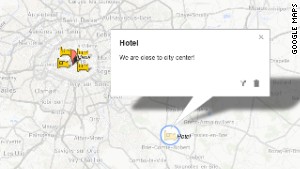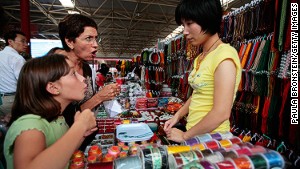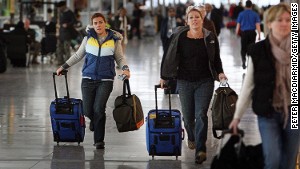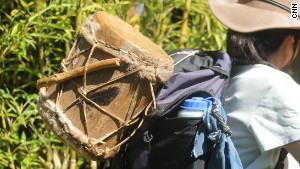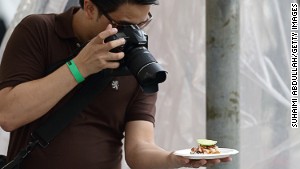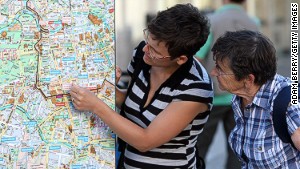Overpacking is a huge mistake that we have all made. It gets better with experience when you find you are bringing back clothes/shoes not used. Take extra ziplock bags for items purchased during your travel. We always advise our clients to check with credit card and cell phone companies before traveling. There may be an international plan available to save money on phone calls or internet usage while traveling abroad. Here is the article:
Doh! 20 biggest travel mistakes
By Chuck Thompson, CNN
August 2, 2013 -- Updated 0705 GMT (1505 HKT)
(CNN) -- The CNN Travel staff has put in some hard miles.
Collectively, we've touched down on every continent on earth and we're closing in on every country.
But we're nowhere near perfect travelers.
Every one of the travel
chokes on this list comes from painful personal experience -- often
multiple times repeating the same mistakes. (We're nothing if not
persistent.)
What are your biggest travel mistakes? Add them to the list in the comments section below.
1. Overpacking
At home, with your
complete wardrobe available, there's no reason not to run through work,
workout and working-the-clubs outfits in a single day.
But when your life is crammed into a couple bags, your fashion morality changes.
Those socks you wore on the plane should be good for another go.
The purple tee you slept in ought to be alright for a third wear.
Yesterday's undies? Well ...
According to a recent
survey by Travelodge, two-thirds of travelers typically return from a
trip with at least six unworn outfits.
The lesson: You don't need a new set of anything for each day of a trip. Figure on at least two wears for (almost) everything.
2. Not buying something you like as soon as you see it
You think you're gonna circle back to that shop.
You think you'll see a cheaper, better version somewhere else.
You won't.
That evocative street
painting or those Metallica nesting dolls you didn't buy? Now not having
them will haunt you for the rest of your life.
When you see something you like, just buy it and live without regret.
3. Not checking your phone plan before traveling abroad
What you call "international roaming" your phone carrier calls "shareholder dividend!"
A week of texts from
Singapore or St. Lucia shouldn't cost more and hurt worse than open
heart surgery. But it happens all the time to travelers who fail to
check their phone plans before departure.
4. Trusting "near city center" descriptions
"Near city center" is like a Bible verse -- open to vast interpretation.
When you find the money
you saved on your "near city center" hotel is being spent on 30-minute
commutes and outrageous taxi fares, you know you've committed one of the
cardinal sins of travel.
Related note: Except by
purely technical definition, if you're staying near the convention
center in Portland, Oregon, you're decidedly not staying "downtown" (as
is popularly advertised) by any local sensibility.
5. Taking the "super" shuttle
Wait on the curb for a
ride in a sweat-soaked van and risk being the last one dropped off on a
nine-hotel run, all in the name of saving a few bucks?
Your time is worth more than that.
Adam Carolla brilliantly sums up this classic travel blunder in his book, "
In Fifty Years We'll All Be Chicks."
"The shuttle is the
worst $20 you'll ever save. It adds 90 minutes to whatever a Town Car or
cab would have been. You have the unenviable choice between being
dropped off last or being dropped off first and having a bunch of losers
who can't afford cab fare and have no friends or loved ones with cars
knowing exactly where you live."
Perfect way to ruin an arrival -- shampoo snot.
6. Not tightening shampoo caps ... all the way
Those cute, little
trial-size shampoo and conditioner bottles are really handy -- until
they magically burst open in-flight, spreading a layer of glycerol soap
snot all over your bag.
7. Thinking you know the perfect time to book a ticket
There's an art to
reading the tea leaves of the airlines' protean pricing schemes, but
there's some muddled science to it, as well.
According to
Travelers Today,
research conducted by CheapAir concluded that you can find the cheapest
fares 79 days before domestic flights and 81 days before international
flights. But Kayak found the optimal timing for a cheap-ticket purchase
is 21 and 34 days before domestic and international flights,
respectively.
Meanwhile, researchers at
Texas A&M University simply found that Saturdays and Sundays are best for finding discount fares.
The golden rule?
There's no golden rule. Tickets are cheapest when they're cheapest.
Congrats, you just saved 50 cents. Now go get your blood pressure checked.
8. Trying too hard to chisel out a bargain
There's no faster way to
become embittered with the locals than going toe-to-toe with a market
full of hungry sales people and shopkeepers.
Yes, we understand
there's principle involved, but do you really need to whittle the
equivalent of fifty cents off the price of an embroidered handbag that's
going to sit in the back of a closet anyway?
Just buy the damn thing and spare your heart the cortisol burst for when it actually needs it.
9. Not changing money at the airport
When traveling
internationally, the conventional wisdom is that only amateurs change
money at the airport, because the exchange rate for foreign currency
will be better in town.
It usually is, but often not by that much.
A recent check of the
dollar-to-pound exchange rate in London Heathrow was $1.71 to £1 (with
no commission for changes more than $300).
Near Oxford Circus the exchange rate was advertised at $1.62 to £1, also with no commission.
Using these rates, converting $300 at the airport would get you £175.43 as opposed to £185.18 on the street.
So, you can hit the city
like a cashless bumpkin and spend an hour hunting up an acceptable
place to change money or, for less than £10, arrive with some local coin
in your pocket.
Convenience factor alone makes it worth changing at least a nominal amount of cash at the "ripoff" place at the airport.
On the plus side, you're also getting in your day at the gym.
10. Underestimating the hell that is Heathrow
Speaking of London, it's
easy to underestimate the several hundred miles of concourse you'll
likely be obliged to traverse and the time-consuming security searches
that create jumbled queues and make travelers look more like internment
camp refugees than cosmopolitan jet setters.
Arriving anything less than two hours before an international flight is risky, but even a longer cushion can get dicey.
Imagine walking across a
football stadium and you start to get an idea of the Andean trek from
the Heathrow Express station to the swarm of travelers clamoring to get
on lifts that will take them merely to their start of the Oz-like
journey through Terminal 1.
11. Buying cheap flip-flops
You think, "I'm only gonna wear 'em for a week, I might not even take 'em home, why buy the good ones?"
The answer comes when you blow out a toe strap and shred the bottom of your foot a mile into a hike across the local lava beds.
And now you have to go back.
12. Fearing street food
No one wants to get sick on vacation, but why travel all the way to Thailand or Mexico and not eat the local grub?
The locals don't like
food poisoning any more than you do. If they're in line, consider the
place vetted and assume you're going to be fine.
(Cue angry commenters
with the "I almost died from a tainted falafel" and "the locals are
immune to bacteria" histrionics below.)
Buy a drum on your trip? Sounds dumb.
13. Buying a drum on the first day of a three-month trek across Asia
We know, this is the
antithesis of travel mistake number two, but there are some balls and
chains you really don't want to lug around the subcontinent.
Not because you'll make
instant enemies with everyone in your hostel when they spy you
struggling top-heavily into the dorm, but because a) you'll never play
the thing, and b) you'll get back home, walk into the new Authentic
Beats music shop that replaced your favorite bookstore while you were
away and find 10 superior examples of your exact instrument.
14. Over-reliance on guidebooks
Making a travel plan using only your guidebook is like making a plan to stand in line at the bank for a week.
Guidebooks are great --
we use them all the time -- but it's best to pull just one or two
suggestions per day from a guide that thousands of like-minded travelers
have read or downloaded.
15. Not buying the full insurance policy
We're not a bunch of
free spenders -- except when the boss whips out the company credit card
at the pub -- but a lot of the mistakes on this list come down to adding
a significant amount of stress to your life in the name of saving a few
bucks.
If you actually end up
needing the travel insurance you purchased (a move a significant
percentage of our staff thinks is silly in the first place), you're
going to want the full coverage.
Just because you're in a country where the beer is cheap, it doesn't mean the healthcare is.
That bargain insurance
policy might pay for your flight home when you crash your motor scooter
on a winding road in some island paradise.
But it won't cover the $5,000 in stitches and sponge baths you racked up during your three-day international hospital stay.
Pity the friends back home who'll have to scroll through the lot of them. Assuming he has any.
16. Obsessive photography
The obsession/obligation
to document every street scene, statue and starter course kills the
spontaneity and visceral experience that should be the backbone of
travel.
It's now so easy to take photos that one click leads to another.
Before you know it, you have 300 pictures on your phone comprising old buildings, blurry sunsets and plates of food.
Congratulations. Your
trip is now defined by low-quality images on a handset that, trust us,
nobody back home wants to spend 20 minutes scrolling through.
17. Not checking visa requirements before departure
Carnival Rio!
It's a nightmare come
true when you get turned away at the ticket counter on departure day
because you didn't realize Brazil requires citizens of your benighted
country to secure a visa before travel.
18. Attempting Berlin in a weekend
At
344 square miles, Berlin is a metropolitan Goliath, larger than New York City (
301 square miles), and, as the first-time visitor quickly learns, with just as many places to see, eat, drink, shop and get lost.
19. Using a credit card to get cash
This is the fastest way of paying through the nose for the privilege of paying through the nose.
Credit card companies charge a high transaction fee (up to 15%) for using a card to get cash.
These special
transactions also attract a higher associated fees than other purchases:
the ATM-owning bank will charge a fee; if you're withdrawing a foreign
currency the exchange rate will be miserly; and if you're not paying off
your balance each month, credit card companies in some countries will
apply your partial payments to normal purchases (with a lower interest
rate, say 9%) before applying them to those cash advances (which have a
much higher interest rate), milking your desperation for every pitiless
penny.
"As I recall from the website, we were staying somewhere around here."
20. Not printing out reservation details
They're already on your phone and computer, so why bother with hard copies of your hotel name and address?
Because your phone,
computer, tablet and other electronics might not work with the local
network as soon as you land, especially after crossing oceans.
Now where are you supposed to go?





